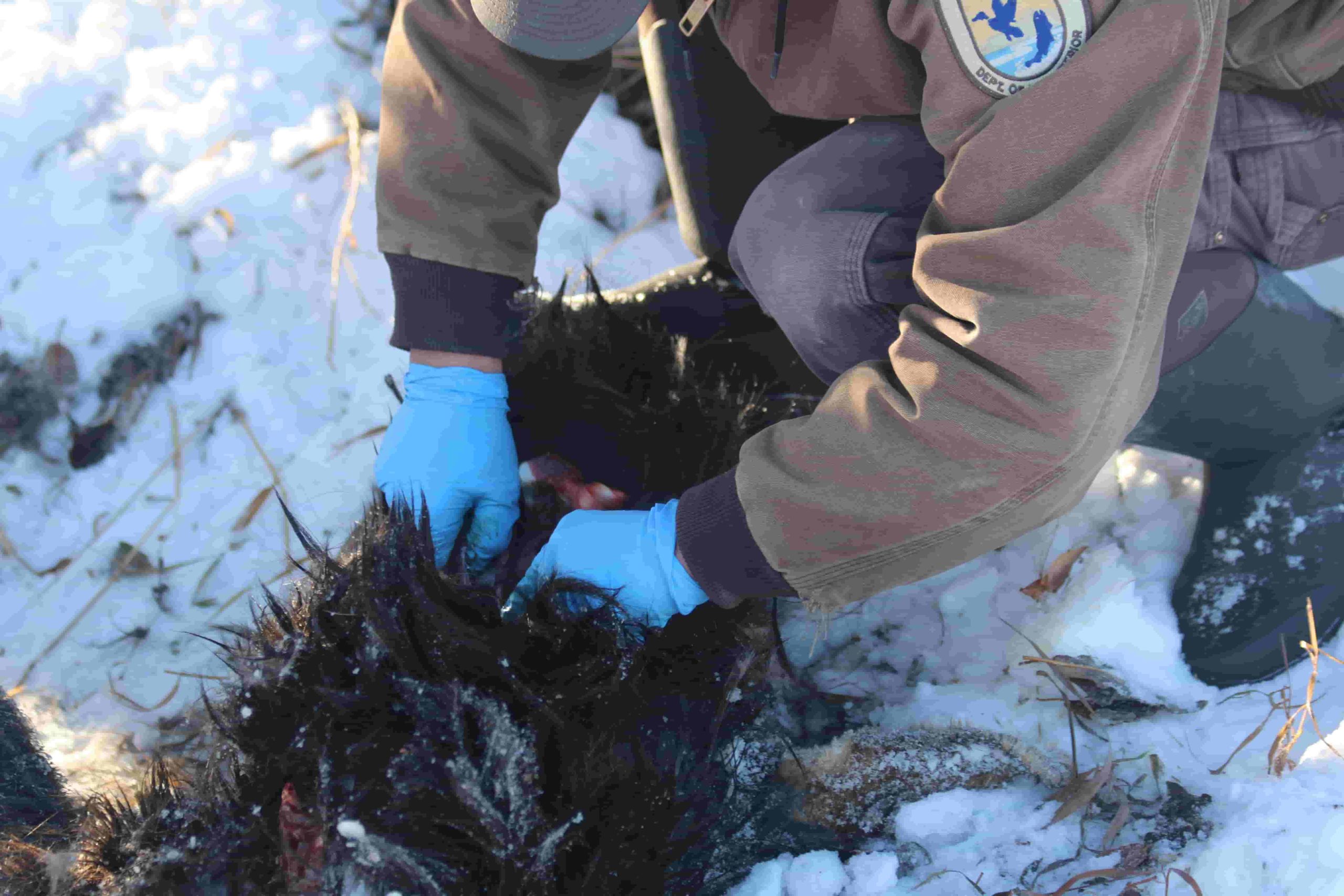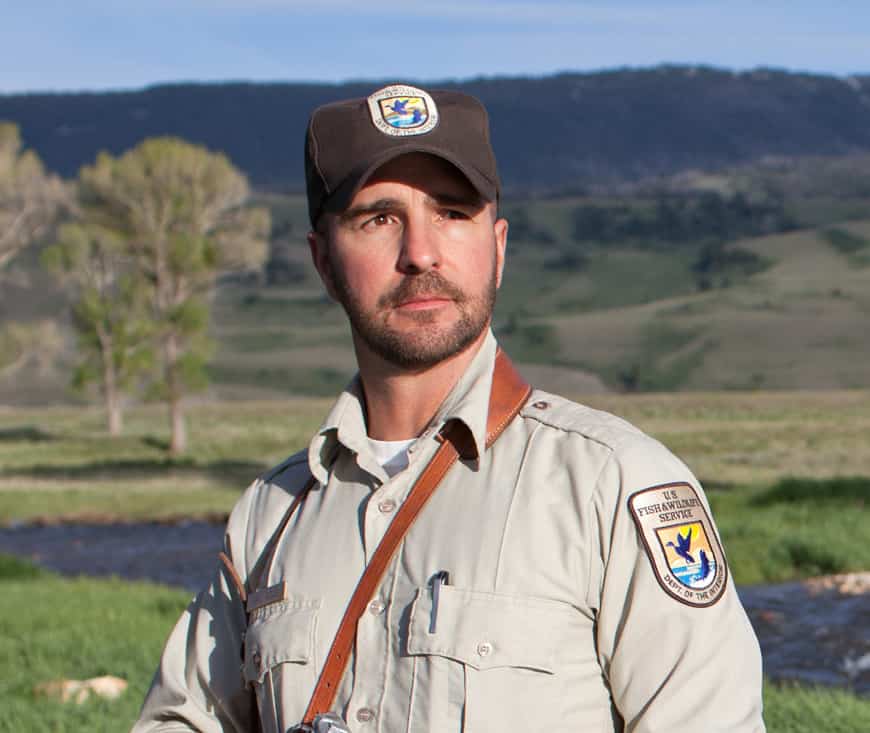Author: Eric K. Cole
Organization: National Elk Refuge, U.S. Fish and Wildlife Service
Title: Reducing Reliance on Supplemental Feeding at the National Elk Refuge
The National Elk Refuge conducts one of the largest wildlife feeding operations in the world. During most winters, approximately 7,500 elk from the Jackson Elk Herd (JEH) and 500 bison from the Jackson Bison Herd receive supplemental alfalfa pellets. Supplemental feeding on the Refuge reduces elk starvation, supports greater elk numbers than could be supported by existing native winter range, and minimizes elk and bison conflicts with people on surrounding private lands and roadways.
However, feeding also artificially concentrates elk (See Janousek et al. 2021), which increases disease occurrence and prevalence. The diseases brucellosis, pasteurellosis, scabies, and foot rot are prevalent in Refuge elk, but are generally uncommon in unfed elk populations. With the first detection of chronic wasting disease (CWD) in the JEH in 2020, the best available evidence suggests that CWD will have significant negative effects on elk survival rates and the JEH population growth rate over time (See Galloway et al. 2017).
In an effort to reduce reliance on supplemental feeding and reduce disease risk, the Refuge developed the Step-Down Plan. The principal strategy of the Step-Down plan is to reduce feed season length, which we hypothesize will lead to redistribution of elk to other wintering areas over time, result in fewer elk wintering on the Refuge, and reduce disease risk in the JEH. Over several years, the goal is to reduce the number of elk wintering on the Refuge to 5,000, a population level closer to the natural carrying capacity of the Refuge and surrounding area. Hypothetically, with 5,000 elk and 500 bison wintering on the Refuge, feeding would only be necessary during severe winters (See Hobbs et al. 2002).
Implementation of the Step-Down Plan presents challenges. Shortened feed seasons could result in elk and bison leaving the Refuge during winter months, causing property damage on surrounding private lands. We will evaluate the effects of reduced feed season length by monitoring elk and bison distribution, elk winter mortality rates, and disease prevalence. We will compare these metrics to baseline data collected prior to the implementation of the Step-Down Plan.
Intensive monitoring, increased public tolerance of elk and bison, and mitigation strategies to reduce conflicts between wildlife and people on private lands will be necessary to ensure project success. The Refuge will work directly with surrounding ranchers, private land owners and other partners to minimize conflicts with elk and bison. The Refuge will inform the public about the project via news releases, information on the National Elk Refuge website, and exhibits and presentations at the Interagency Visitor Center.
 Photo 1: A biologist collects a lymph node sample from a bull elk that died on the Refuge to test for Chronic Wasting Disease (CWD). Refuge employees collect samples from elk that die on the Refuge to test for CWD, and hunters that kill an elk on the Refuge must submit samples to test for CWD. The first CWD case in the Jackson elk herd was detected in 2020. The best available evidence suggests that artificial elk crowding associated with supplemental feeding will increase the prevalence of CWD in elk over time, and that this will result in significant negative effects on the elk population. Under the Refuge’s Step-Down Plan, feed season length will be reduced to mitigate the risk of CWD and other diseases. Photo credit: Lori Iverson, USFWS.
Photo 1: A biologist collects a lymph node sample from a bull elk that died on the Refuge to test for Chronic Wasting Disease (CWD). Refuge employees collect samples from elk that die on the Refuge to test for CWD, and hunters that kill an elk on the Refuge must submit samples to test for CWD. The first CWD case in the Jackson elk herd was detected in 2020. The best available evidence suggests that artificial elk crowding associated with supplemental feeding will increase the prevalence of CWD in elk over time, and that this will result in significant negative effects on the elk population. Under the Refuge’s Step-Down Plan, feed season length will be reduced to mitigate the risk of CWD and other diseases. Photo credit: Lori Iverson, USFWS.
 Photo 2: To monitor elk migration patterns, habitat use, and evaluate the effects of the Step-Down Plan on elk distribution, we have deployed GPS collars on 136 elk since 2016. Each collar collects a very accurate location for that elk every 1.5 hours (shown as yellow dots in this image). The image shows the portion of the National Elk Refuge immediately north of the town of Jackson, WY and demonstrates how rare it is for elk to enter the town of Jackson under the current supplemental feeding regime. As supplemental feed seasons are shortened under the Step-Down Plan, elk movements during winter months to private lands surrounding the Refuge could become more likely. Maintaining a sample of elk with GPS collars will enable us to closely monitor elk movements and reduce conflicts between elk and people. Photo credit: Eric Cole, USFWS.
Photo 2: To monitor elk migration patterns, habitat use, and evaluate the effects of the Step-Down Plan on elk distribution, we have deployed GPS collars on 136 elk since 2016. Each collar collects a very accurate location for that elk every 1.5 hours (shown as yellow dots in this image). The image shows the portion of the National Elk Refuge immediately north of the town of Jackson, WY and demonstrates how rare it is for elk to enter the town of Jackson under the current supplemental feeding regime. As supplemental feed seasons are shortened under the Step-Down Plan, elk movements during winter months to private lands surrounding the Refuge could become more likely. Maintaining a sample of elk with GPS collars will enable us to closely monitor elk movements and reduce conflicts between elk and people. Photo credit: Eric Cole, USFWS.

Eric Cole has worked for the National Elk Refuge for 23 years and has served as the Refuge’s senior wildlife biologist since 2004. His principal duties are to monitor the Jackson elk herd, evaluate the effects of Refuge management activities on biological systems, and oversee the Refuge’s supplemental feeding program.
